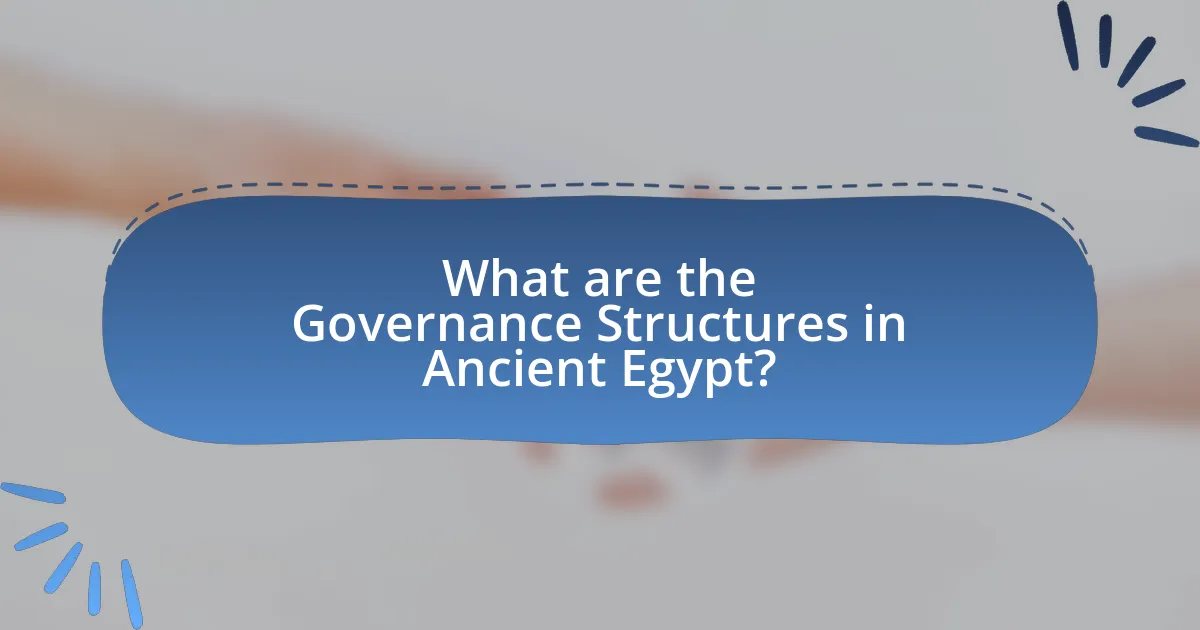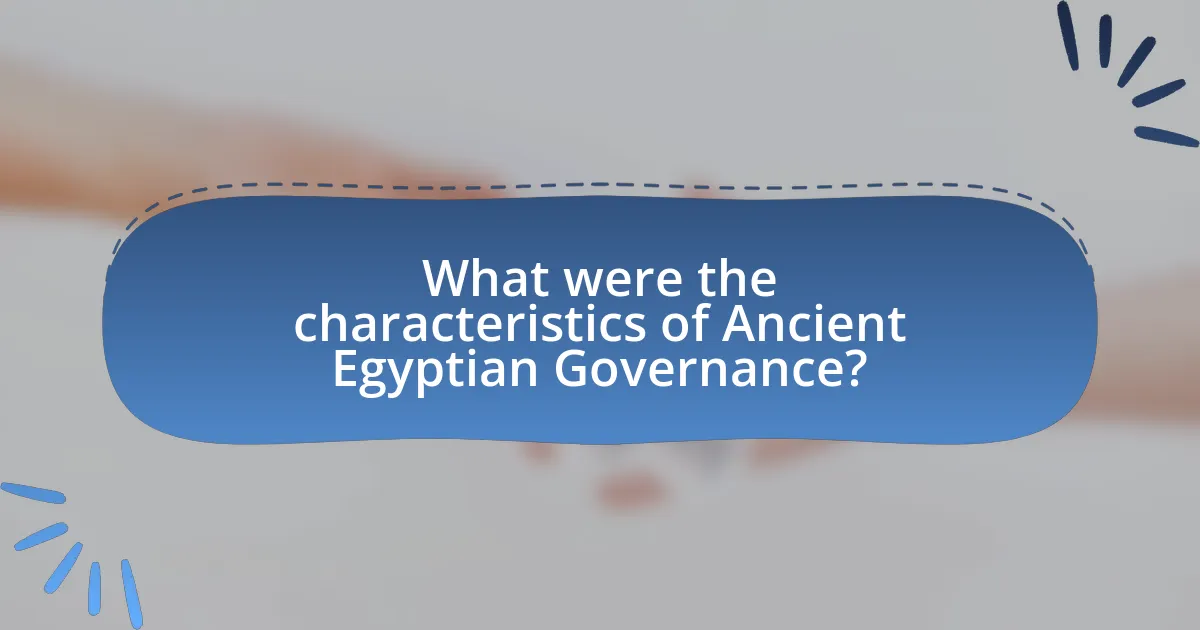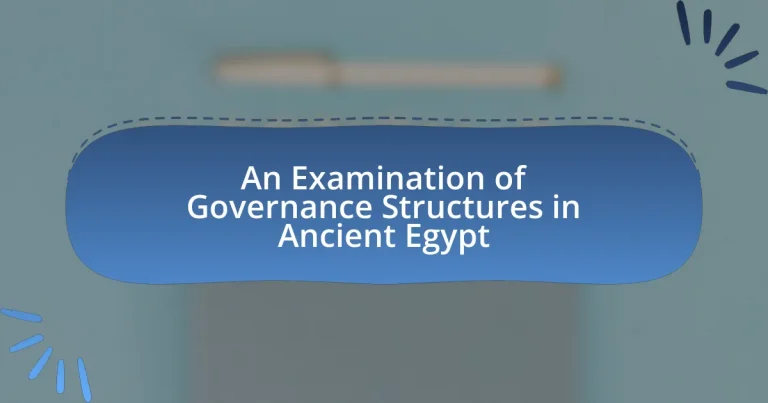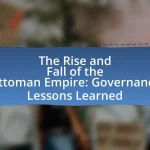The article examines the governance structures of Ancient Egypt, highlighting the centralized authority of the Pharaoh, who served as both a political and religious leader. It details the hierarchical political system, including the roles of viziers, nomarchs, and local officials, and emphasizes the importance of a complex bureaucracy in maintaining order and resource management. The article also explores the intertwining of religion and governance, the legal frameworks in place, and the impact of these structures on social stratification and economic activities. Key institutions, such as the priesthood and the legal system, are discussed in relation to their influence on political decisions and societal stability.

What are the Governance Structures in Ancient Egypt?
The governance structures in Ancient Egypt were primarily centralized under the authority of the Pharaoh, who was considered both a political and religious leader. The Pharaoh’s power was supported by a bureaucratic system that included various officials, such as viziers, who managed different aspects of governance, including taxation, agriculture, and justice. This hierarchical structure ensured that the Pharaoh’s decrees were implemented throughout the kingdom, with local governors overseeing regions known as nomes. The reliance on a complex bureaucracy allowed for efficient administration and control over resources, which was crucial for maintaining the stability and prosperity of Ancient Egypt. Historical records, such as the Rosetta Stone and inscriptions from temples, provide evidence of this structured governance system and its effectiveness in managing one of the earliest civilizations.
How did the political hierarchy function in Ancient Egypt?
The political hierarchy in Ancient Egypt was structured with the Pharaoh at the top, serving as both the political and religious leader. Below the Pharaoh were high-ranking officials, including viziers, who managed the administration and implemented the Pharaoh’s policies. The hierarchy continued with regional governors, known as nomarchs, who oversaw various districts, and local officials who managed day-to-day governance. This system ensured centralized control while allowing for local administration, facilitating effective governance across the vast territory of Egypt. Historical records indicate that this hierarchy was crucial for maintaining order, collecting taxes, and mobilizing labor for large projects, such as the construction of pyramids, demonstrating its effectiveness in managing the state’s resources and workforce.
What roles did the Pharaoh play in governance?
The Pharaoh served as the supreme ruler and central authority in governance, embodying both political and religious leadership in ancient Egypt. This role included making laws, collecting taxes, and overseeing the administration of justice, which were essential for maintaining order and stability in society. The Pharaoh was also considered a divine figure, believed to be the intermediary between the gods and the people, which reinforced their authority and legitimacy. Historical records indicate that Pharaohs like Ramses II implemented extensive building projects and military campaigns, further demonstrating their governance role in shaping the nation’s infrastructure and defense.
How were local governors and officials organized?
Local governors and officials in ancient Egypt were organized into a hierarchical structure that facilitated the administration of various regions. At the top of this hierarchy were nomarchs, who governed individual nomes or provinces, overseeing local administration, tax collection, and law enforcement. Below the nomarchs, officials such as scribes and treasurers managed specific functions like record-keeping and financial matters. This organization ensured efficient governance and resource management, as evidenced by the extensive records found in archaeological sites, which detail the roles and responsibilities of these officials in maintaining order and supporting the central authority of the Pharaoh.
What were the key institutions involved in governance?
The key institutions involved in governance in Ancient Egypt included the Pharaoh, the vizier, the nomarchs, and the priesthood. The Pharaoh served as the supreme ruler and was considered a divine figure, central to the governance structure. The vizier acted as the chief advisor and administrator, overseeing the day-to-day operations of the state and implementing the Pharaoh’s policies. Nomarchs governed individual provinces, managing local affairs and collecting taxes. The priesthood held significant power, controlling religious practices and influencing political decisions, as religion was deeply intertwined with governance. These institutions collectively maintained order and facilitated the administration of Ancient Egypt, ensuring the stability and continuity of the state.
What was the role of the vizier in Ancient Egyptian governance?
The vizier in Ancient Egyptian governance served as the highest official under the pharaoh, acting as the chief advisor and administrator of the state. This role included overseeing the administration of justice, managing state finances, and supervising large-scale construction projects, such as temples and monuments. The vizier was responsible for implementing the pharaoh’s policies and ensuring the smooth operation of the government, which was crucial for maintaining order and stability in Ancient Egypt. Historical records indicate that viziers often held significant power, with some even acting as regents during the pharaoh’s absence, highlighting their importance in the governance structure of Ancient Egypt.
How did the priesthood influence political decisions?
The priesthood in ancient Egypt significantly influenced political decisions by serving as intermediaries between the gods and the pharaoh, thereby legitimizing the ruler’s authority. This relationship allowed priests to wield considerable power, as they controlled vast resources, including land and wealth from temple donations, which they could leverage to support or oppose political initiatives. For instance, the high priests of Amun at Karnak became politically influential, especially during the New Kingdom, where they could challenge the pharaoh’s decisions or support military campaigns, impacting governance and state policies directly.

What were the characteristics of Ancient Egyptian Governance?
Ancient Egyptian governance was characterized by a centralized authority led by the Pharaoh, who was considered both a political and religious leader. The Pharaoh’s power was absolute, supported by a bureaucratic system that included officials and priests who managed various aspects of society, such as agriculture, trade, and taxation. This governance structure was reinforced by the belief in Ma’at, the principle of order and justice, which guided the laws and policies of the state. Additionally, the use of hieroglyphics for record-keeping and communication facilitated administrative efficiency, allowing for effective management of resources and population. The construction of monumental architecture, such as temples and pyramids, also reflected the governance’s focus on demonstrating power and divine connection.
How did religion intertwine with governance in Ancient Egypt?
Religion was integral to governance in Ancient Egypt, as the Pharaoh was considered both a political leader and a divine figure. This dual role established a theocratic system where religious beliefs legitimized the authority of the state. The Pharaoh’s divine status was reinforced through rituals, temples, and the belief in the afterlife, which were essential for maintaining social order and political stability. For instance, the construction of monumental temples served not only as places of worship but also as centers of administration and economic power, illustrating the close relationship between religious institutions and governance.
What was the significance of divine kingship?
Divine kingship in ancient Egypt was significant as it established the pharaoh as both a political and spiritual leader, embodying the divine order on Earth. This dual role reinforced the legitimacy of the pharaoh’s authority, as rulers were believed to be chosen by the gods, particularly Horus, and were responsible for maintaining maat, or cosmic order. The significance is further evidenced by the construction of monumental temples and pyramids, which served as both tombs and places of worship, illustrating the intertwining of governance and religion in sustaining societal stability and continuity.
How did religious practices affect administrative functions?
Religious practices significantly influenced administrative functions in ancient Egypt by intertwining governance with spiritual authority. The Pharaoh, regarded as a divine figure, utilized religious rituals to legitimize political power and maintain social order. For instance, the construction of temples and the organization of religious festivals required extensive bureaucratic coordination, which reinforced the administrative structure. Additionally, the priesthood held considerable sway over resources and land, often acting as intermediaries between the gods and the people, thereby shaping economic policies and local governance. This integration of religion and administration ensured that the state’s operations aligned with divine will, as evidenced by the central role of religious decrees in legal and administrative decisions.
What legal frameworks existed in Ancient Egypt?
Ancient Egypt had a legal framework primarily based on a combination of royal decrees, customary laws, and religious principles. The Pharaoh, as the supreme ruler, enacted laws that were often considered divine commands, reflecting the belief that the king was a god on earth. Additionally, local customs and traditions played a significant role in legal practices, with local officials and priests often administering justice according to these established norms. The existence of legal texts, such as the “Instructions of Ptahhotep,” illustrates the codification of laws and ethical guidelines, reinforcing the structured nature of governance and legal proceedings in Ancient Egypt.
What were the main laws governing society?
The main laws governing society in ancient Egypt included the concept of Ma’at, which represented truth, balance, and order, and was foundational to legal and moral conduct. These laws were enforced by the Pharaoh, who was considered a divine ruler, and included regulations on property rights, trade, marriage, and criminal justice. The Code of Hammurabi, while not Egyptian, influenced legal thought in the region, emphasizing the importance of justice and societal order. Additionally, local customs and decrees played a significant role in the application of laws, reflecting the values and norms of various communities within ancient Egypt.
How were disputes resolved within the governance structure?
Disputes within the governance structure of Ancient Egypt were primarily resolved through a combination of legal proceedings and the intervention of officials, such as viziers or local judges. The legal system was based on a codified set of laws, and individuals could bring their grievances before these officials, who would then adjudicate based on established legal principles. Historical records indicate that the vizier, acting as the highest judicial authority, played a crucial role in mediating disputes, ensuring that justice was administered in accordance with the Pharaoh’s decrees and societal norms. This structured approach to conflict resolution helped maintain order and stability within the society.

What were the impacts of Governance Structures on Ancient Egyptian Society?
Governance structures in Ancient Egypt significantly influenced social organization, economic stability, and cultural development. The centralized authority of the Pharaoh, viewed as a divine ruler, established a hierarchical system that ensured political unity and control over resources. This structure facilitated large-scale agricultural projects, such as irrigation systems, which supported population growth and economic prosperity. Additionally, the governance framework allowed for the establishment of a complex bureaucracy, enabling efficient tax collection and resource distribution, which further strengthened the state. The legal and administrative systems developed under these governance structures also promoted social order and cultural achievements, including monumental architecture and advancements in writing and art.
How did governance affect social stratification in Ancient Egypt?
Governance in Ancient Egypt significantly influenced social stratification by establishing a hierarchical system where the Pharaoh held supreme authority, followed by a class of nobles, priests, and officials. This centralized governance allowed for the distribution of resources and power, reinforcing the social hierarchy. The Pharaoh, viewed as a divine ruler, dictated laws and policies that favored the elite, ensuring their wealth and status while relegating the majority of the population, including farmers and laborers, to lower social classes. Historical records indicate that the bureaucratic structure, which included scribes and administrators, was essential in maintaining this stratification by managing agricultural production and taxation, further entrenching the divide between the upper and lower classes.
What roles did different social classes play in governance?
In Ancient Egypt, different social classes played distinct roles in governance, with the pharaoh at the top, followed by nobles, priests, scribes, and laborers. The pharaoh, considered a divine ruler, held ultimate authority and was responsible for law-making and maintaining order. Nobles, often related to the pharaoh, managed large estates and acted as local governors, overseeing regions and collecting taxes. Priests held significant power, controlling religious practices and influencing political decisions, as religion was intertwined with governance. Scribes, educated in writing and administration, documented laws, tax records, and state affairs, serving as the bureaucratic backbone of governance. Laborers, while not directly involved in governance, contributed to the economy and infrastructure, which supported the ruling class’s authority. This hierarchical structure ensured that governance was maintained through a combination of divine, political, and economic power, reflecting the interconnectedness of social classes in Ancient Egyptian society.
How did governance influence economic activities?
Governance in Ancient Egypt significantly influenced economic activities by establishing a centralized authority that regulated trade, agriculture, and resource distribution. The Pharaohs implemented policies that controlled land ownership and agricultural production, ensuring that surplus crops were collected as taxes, which supported state projects and the economy. For instance, the state organized large-scale irrigation projects to enhance agricultural output, directly impacting food supply and trade. Additionally, the administration enforced trade regulations, facilitating commerce with neighboring regions, which expanded economic interactions and wealth accumulation. Historical records indicate that the centralized governance structure allowed for efficient resource management, contributing to the stability and prosperity of Ancient Egypt’s economy.
What lessons can be learned from Ancient Egyptian governance structures?
Ancient Egyptian governance structures demonstrate the importance of centralized authority and the integration of religion in political systems. The Pharaoh, viewed as a divine ruler, held absolute power, which facilitated the unification of the state and the implementation of large-scale projects, such as the construction of pyramids and temples. This centralization allowed for efficient resource allocation and social order, as evidenced by the successful management of agricultural production along the Nile River, which was crucial for sustaining the population. Additionally, the use of a bureaucratic system, with officials overseeing various aspects of governance, highlights the effectiveness of delegation in administration. The reliance on a codified system of laws, such as the Ma’at, reinforced social stability and justice, illustrating the significance of legal frameworks in governance. These lessons underscore the value of strong leadership, the role of religion in legitimizing authority, and the necessity of structured administrative systems in achieving societal cohesion and progress.
How can modern governance benefit from studying Ancient Egypt?
Modern governance can benefit from studying Ancient Egypt by analyzing its centralized administrative systems and legal frameworks. Ancient Egypt’s governance was characterized by a strong central authority, exemplified by the Pharaoh’s role as both a political and religious leader, which facilitated efficient decision-making and resource allocation. The use of a codified legal system, such as the Ma’at principles, provided a foundation for justice and social order, emphasizing the importance of laws in maintaining societal stability. These historical insights can inform contemporary governance by highlighting the effectiveness of centralized authority and the necessity of a robust legal framework to ensure fairness and accountability in modern states.
What best practices from Ancient Egyptian governance are still relevant today?
Best practices from Ancient Egyptian governance that remain relevant today include centralized authority, legal codification, and public works management. Centralized authority, exemplified by the Pharaoh’s role as both a political and religious leader, ensured unified decision-making and stability, a principle still seen in modern governments where strong leadership can drive national policy. Legal codification in Ancient Egypt, such as the establishment of laws that governed daily life and trade, laid the groundwork for contemporary legal systems that rely on written laws to maintain order and justice. Additionally, the emphasis on public works, including irrigation systems and monumental architecture, highlights the importance of infrastructure development for economic growth and societal welfare, a practice that continues to be a priority in modern governance for fostering community and economic resilience.


